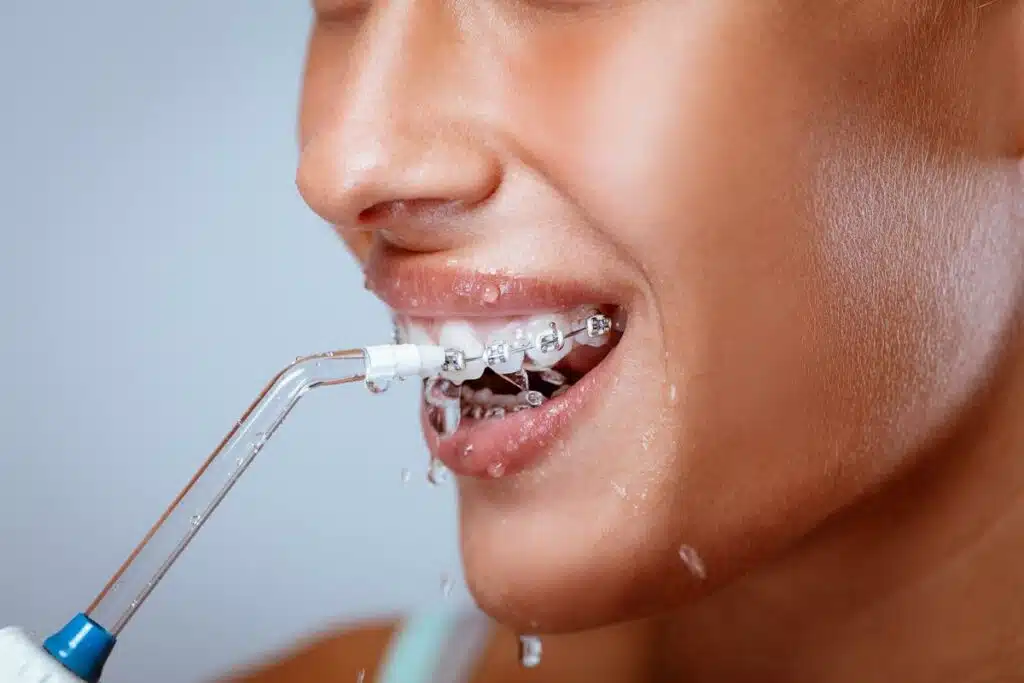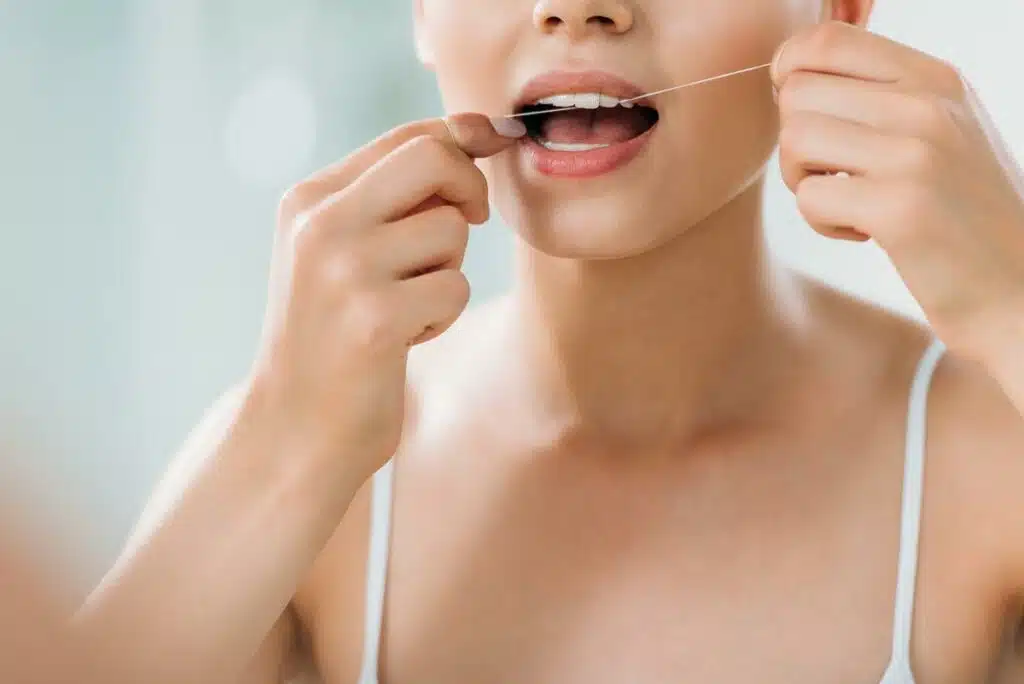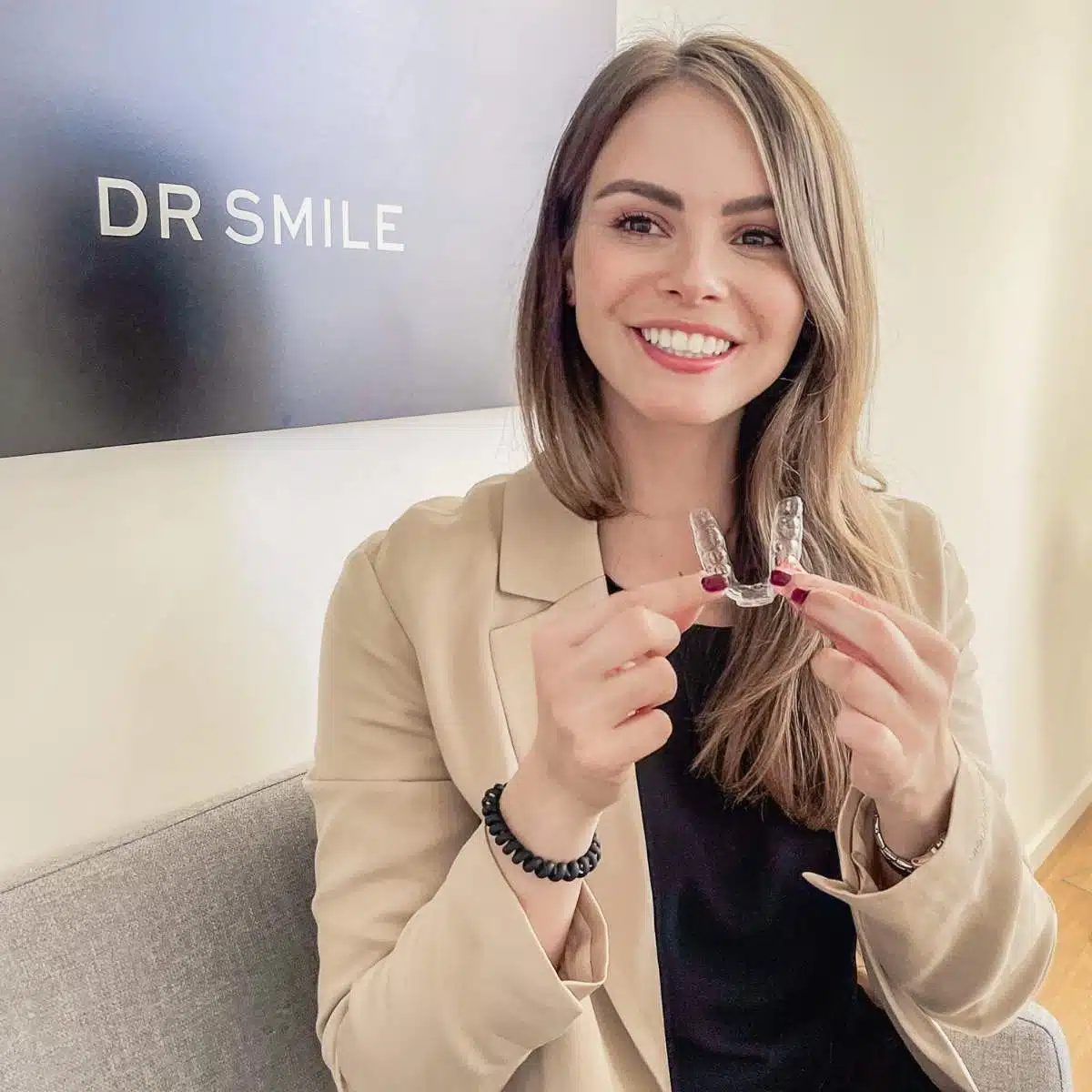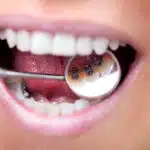Cleaning interdental spaces: What are the pros and cons of dental floss, oral irrigators & co. and which products work best?
Thorough cleaning of the spaces between teeth is a crucial part of oral hygiene and plays a major role in keeping teeth and gums healthy.
While daily tooth brushing is often taken for granted, the care of interdental spaces remains a neglected routine for many.
It is precisely in these narrow spaces between the teeth that food debris and bacteria often hide, which can lead to plaque, tartar and inflamed gums if they are not removed regularly.
| Get 150 € discount on your dental correction! |

Book a consultation appointment now at a nearby DrSmile partner practice and find out if teeth straightening with aligners is right for you.
The appointment is completely non-binding and does not involve any costs.
With the code “THATSMILE150” you will receive 150 € discount on the treatment.
Why is cleaning interdental spaces so important?
The spaces between the teeth make up around 30 percent of the entire tooth surface. While a toothbrush reaches the outer and inner surfaces of the teeth well, the narrow space between the teeth often remains untouched.
Food residues and bacteria collect in these spaces, which can lead to the formation of plaque and later tartar.
If this plaque remains undisturbed for too long, gum inflammation (gingivitis) and, in the worst case, periodontitis can develop – a serious gum disease that can lead to tooth loss.
Regular cleaning of the interdental spaces helps to minimize the risk of such diseases.

The various options for interdental care
There are various aids available to clean the interdental spaces effectively.
Here you can find out more about the most popular products, the advantages and disadvantages of each product and tips on how to use them.
1. dental floss
Dental floss is one of the best-known and most popular tools for cleaning the spaces between teeth.
It is usually made of fine nylon or PTFE thread, which is designed to slide through the narrow gaps.
- Advantages: Dental floss reaches even narrow spaces and is particularly suitable for people with closely spaced teeth. It is readily available and ideal for daily use. It can also be placed flexibly around each tooth, which enables thorough cleaning.
- Disadvantages: Flossing is not always the best choice for people with sensitive gums or larger interdental spaces. It requires skill to use and can be difficult at first, especially for those who are inexperienced. There is also a risk of injuring the gums if used incorrectly.
2. interdental brushes
Interdental brushes are small, brush-like aids that are available in different sizes and have been specially developed for cleaning the spaces between the teeth.
They usually consist of a thin wire with bristles that are inserted into the spaces between the teeth.
- Advantages: Interdental brushes are ideal for larger interdental spaces and are very effective at removing plaque and food debris. They are easy to use and are particularly popular with people with bridges, implants or braces, as they clean more thoroughly than dental floss.
- Disadvantages: Interdental brushes are often too large for very narrow interdental spaces and could irritate the gums if they are not the right size. It is important to find the right brush size for each interdental space, which can seem a little time-consuming at first. In addition, interdental brushes are usually a little more expensive than dental floss.
3. oral irrigators
An oral irrigator uses a targeted jet of water to remove plaque and food debris from between the teeth.
This method is particularly popular with people who want a gentle and simple cleaning process.
- Advantages: Oral irrigators are particularly gentle on the gums and can be used without any problems even with sensitive teeth and gums. They are a good choice for people with bridges, implants or braces. The water jet also reaches hard-to-reach areas and effectively removes food debris.
- Disadvantages: Compared to dental floss and interdental brushes, oral irrigators are often less thorough when it comes to removing plaque. In addition, the purchase of an oral irrigator is more expensive and the device requires regular maintenance. Some studies suggest that using an oral irrigator alone is not sufficient and that it is better used as a supplement to other cleaning methods.

4. toothpicks and toothpicks
Toothpicks are small, wooden sticks that are used to remove food debris and plaque from between the teeth.
They are available in pharmacies or drugstores and often come in the form of triangular sticks that fit well between the teeth.
- Advantages: Toothpicks are readily available, inexpensive and offer a quick way to remove larger food debris from between the teeth. They are particularly practical for when you are on the move and don’t have a toothbrush to hand.
- Disadvantages: Toothpicks do not remove plaque as thoroughly as dental floss or interdental brushes and are not suitable for regular, thorough cleaning of the interdental spaces. There is also a risk of injuring the gums if used incorrectly.
5. dental picks
Dental picks, also known as interdental picks, are small, flexible plastic sticks with a rubberized tip.
They offer a gentle way to clean between the teeth and are available in different thicknesses.
- Advantages: Dental picks are particularly gentle and are suitable for people with sensitive gums. They are easy to use and their flexibility makes them comfortable for the interdental spaces. Dental picks are also often reusable and particularly practical for on the go.
- Disadvantages: Dental picks can be too thick for very narrow spaces and do not always reach all areas optimally. They are often less effective at removing stubborn plaque and should not be used as the sole cleaning method.
6. floss holder
A floss holder is a small, handy device that holds a piece of dental floss taut.
It facilitates the use of dental floss by enabling easy handling and reducing finger work.
- Advantages: Floss holders are ideal for people who have difficulty using dental floss with their fingers. They offer targeted cleaning and are particularly suitable for people with limited mobility in their hands. They are also practical and facilitate thorough cleaning.
- Disadvantages: Floss holders can be less flexible to achieve different angles between the teeth. They are also often more expensive than conventional floss and produce more waste as the holder has to be disposed of or the floss replaced after each use.

Conclusion on the topic of cleaning interdental spaces for all needs
Regular interdental cleaning is an essential part of dental hygiene and helps to significantly reduce the risk of tooth decay and gum disease.
While floss is a good choice for narrow spaces, interdental brushes are ideal for larger spaces. Oral irrigators, dental picks and floss holders offer additional options that work well as a supplement or for special needs.
It is important to learn the right technique and choose the right product for your individual needs.
If you are unsure which appliance is right for you, you can ask your dentist for advice and try out different methods until you find the one that suits you best.
| Get 150 € discount on your dental correction! |

Book a consultation appointment now at a nearby DrSmile partner practice and find out if teeth straightening with aligners is right for you.
The appointment is completely non-binding and does not involve any costs.
With the code “THATSMILE150” you will receive 150 € discount on the treatment.
FAQs on the topic of cleaning interdental spaces
Here we answer a few of the most frequently asked questions about cleaning interdental spaces.
Why is it important to clean the interdental spaces?
The interdental spaces make up around 30 percent of the tooth surface and are difficult to reach with a toothbrush. This is where food debris and bacteria collect, which can lead to plaque and tartar. Without regular cleaning, the risk of tooth decay and gum disease increases.
Is daily brushing sufficient or is it necessary to use dental floss?
Unfortunately not. The toothbrush usually only reaches the outer and inner surfaces of the teeth. However, bacteria can accumulate in the narrow spaces between teeth, causing tooth decay and inflammation. Additional cleaning of the spaces between the teeth helps to care for these hidden areas.
Which products can I use to clean the interdental spaces?
There are various products for interdental care: dental floss for narrow spaces, interdental brushes for larger spaces, oral irrigators for gentle cleaning and dental picks or floss holders as practical alternatives. Each of these products has its advantages and is suitable depending on individual needs.
How often should I clean the spaces between my teeth?
It is best to clean the spaces between your teeth once a day, ideally in the evening, to remove bacteria and food debris that have accumulated during the day. Regularity is crucial to promote oral health in the long term.
How do I use dental floss correctly?
Take about 30 cm of dental floss and wrap it around your fingers so that a few centimetres are stretched between your thumb and index finger. Carefully insert the dental floss into the space between your fingers and gently slide it back and forth. Be careful not to injure the gums. After each section of tooth, move the dental floss a little further to use clean areas.
What are the advantages of interdental brushes over dental floss?
Interdental brushes are particularly effective for larger interdental spaces, where they can remove plaque and food debris more thoroughly than dental floss. They are also easier to use and cause less friction on the gums, which often makes them more comfortable for people with sensitive gums.
Can I use an oral irrigator instead of dental floss?
Yes, an oral irrigator is a gentle alternative to dental floss and can remove food debris and bacteria from between the teeth with a targeted jet of water. Oral irrigators are particularly popular with people with sensitive gums or braces, but they do not completely replace mechanical cleaning with dental floss or interdental brushes.
How can people with braces or implants clean their interdental spaces?
For people with braces or implants, there are special interdental brushes and oral irrigators that make cleaning easier. Special dental picks with flexible tips are also a good choice for reaching the interdental spaces safely without damaging the braces or implant.



Leave a Reply